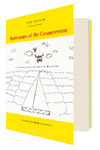Envision a journey informed by a playfully relaxed version of Zeno’s paradox on the impossibility of forward motion, and you’ll have a sense of the spirit presiding over Autonauts of the Cosmoroute. But only a sense, for if this collaborative volume, which recounts a thirty-three-day, 490-mile meander along the Paris-Marseille autoroute, at the carefully calculated rate of two rest stops per day, has an air of high jinks about it, the mad enterprise is also imbued with an air of sweet melancholy, a by-product of the mental and physical demons afflicting the two voyagers. Indeed, given that Canadian writer and activist Carol Dunlop died shortly after the trip was completed, and that Julio Cortázar—Argentinian author of vertiginous twentieth-century experimental classics such as Hopscotch—nearing the end of his own days, was left to finish the resultant book alone, it’s hard not to read a little too much sadness into the proceedings. Happily, though, Autonauts of the Cosmoroute resists projected pathos with the same vigor that “Fafner,” Cortázar and Dunlop’s fiery red VW camper, valiantly resisted the elements.
We know about those elements and the physical circumstances of the voyagers in considerable detail because we are provided with a meticulous daily travel log modeled on the journals of ship captains and explorers: “Friday, 28 May [1982] / Breakfast: oranges, madeleines, fig jam, coffee. / 10:08 Departure. Fog. / 10:15 Stop: AIRE DE LA RESERVE. Cows…” Most of these logs include an entry on the “scientific” observations conducted at each rest stop: “At the second rest area we observed a terra cotta–colored slug, who put its head into an empty beer bottle on the ground. In the evening, after having parked Fafner prudently on a patch of land free of impurities, we cook some sauerkraut.” Photographs and illustrations complement these logs with further charming pseudo-documentary evidence of the conditions being faced, such as the presence, or not, of tourists and businessmen in possession of “mouths with tastes for badly chewed sandwiches.” As charming as these details are, the complex heart of Autonauts resides in its longer narrative portions, which were composed in situ by Cortázar and Dunlop. In these sections, fact, fantasy, love, and neurosis take turns as frames for frequently stunning, occasionally hilarious meditations on a wide variety of subjects, including night on the freeway, the international arms trade, war in the Malvinas (Falklands), rest-stop witches, the nature of wolves, and the cartography of trees.
The seven minutes spent on the road in the instance above are typical of the twice-daily sallies out onto the freeway that the explorers’ itinerary provides for, as this is, after all, an expedition devoted to stopping, to seeing what happens when each rest area “opens its peacock’s tail (sometimes a little sparsely feathered, sometimes splendid and iridescent).” What Cortázar and Dunlop achieve by turning their sustained attention to what is ordinarily considered literally beside the point is a poignant re-visioning of these humble stops along the way, where, after all, the “fiesta of life” is as much on display as anywhere else. The effect is not unlike the one achieved during Nicholson Baker’s epic journey up the escalator in The Mezzanine: getting there never mattered so little; what there was to say en route never mattered so much.
—Laird Hunt





